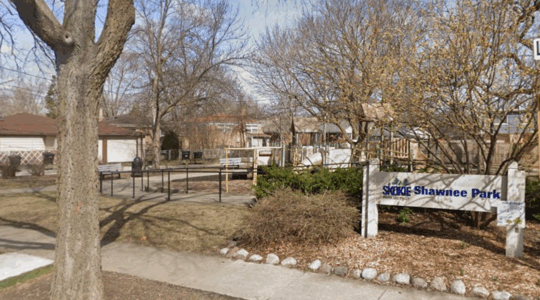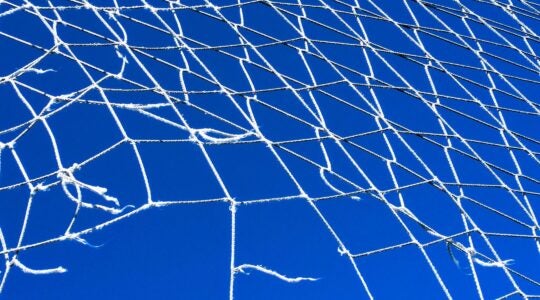
Chasidic singer Mordechai Ben David showing the damage afflicted by Sandy to the Sea Gate community in Brooklyn. (SGSandy via YouTube)
NEW YORK (JTA) — A week after Sandy swept into the New York area with fierce winds, driving rain and a high tide for the history books, the nation’s largest Jewish community was still picking up the pieces. JTA gathered stories from around the storm zone about Sandy’s destruction, the recovery and the remarkable tales of human kindness.
Houses of prayer as places of refuge
Some synagogues in the stricken area have seen more congregants this week than during the High Holidays. Many came for prayer, but others flocked to shuls for their offers of shelter, hot food, heat, recharging of electronics, wireless Internet and children’s programming.
Congregation Keter Torah in Teaneck, N.J., hosted a free pizza night, but the real draw for area residents was the offer to charge electronics. In White Plains, N.Y., in suburban Westchester County, Jewish community members used an email listserv to trade information about which gas stations were open and where the lines were shortest.
In Mahwah, N.J., near the New York State border, locals packed into the social hall at Beth Haverim Shir Shalom to use tables set up with power strips so they could go online.
“I’ve been using my synagogue social hall as an office,” Joe Berkofsky, managing director of communications for the Jewish Federations of North America, told JTA. “I’ve been powering things up and have been able to get some work done.”
Russian-American Jews unite
Steve Asnes, an activist in the Russian Jewish community, was helping neighbors in the Brighton Beach section of Brooklyn on the night of the storm when a sudden surge brought water careening through the streets and up to his neck, according to Mordechai Tokarsky, director of the Russian American Jewish Experience. Asnes managed to hang onto a piece of scaffolding until he could reach safety.
At the nearby RAJE center, Michael Britan watched the center’s first floor turn into a swimming pool. The full extent of destruction became apparent only the next day. Cars lay on top of each other. The RAJE center was under 12 feet of water, its beit midrash study hall wrecked, and classrooms, offices, a boiler room and the elevator shaft all waterlogged.
Community activists who came to help clean up ended up spending much of the time at a high-rise apartment building across the street assisting elderly residents trapped in their homes without power or hot water, Tokarsky said. With the help of Esther Lamm, a RAJE alumna who heads the young leadership Russian division of UJA-Federation in New York, the volunteers quickly organized a command-and-control center that played a key role in relief efforts throughout the neighborhood.
Tokarsy said it would require plenty of work and help from private funders to get RAJE back up and running.
UJA-Federation providing $10 million
The lights were still out and the gas lines still miles long in parts of New York City when the UJA-Federation of New York announced Monday that it was making $10 million available immediately to synagogues, Jewish day schools and federation agencies providing direct care and support in storm-hit communities. The money will go toward cash assistance, temporary housing, food and “whatever else is needed,” federation CEO John Ruskay told JTA. The unanimous decision was made in an emergency board meeting on Sunday night.
The money will come from the federation’s endowment and reserves, and will be offset by any storm-related donations. “The point of having reserves and an endowment is to enable our agencies, our synagogues and our community to respond to people at times like these,” Ruskay said. It’s the largest-ever commitment of UJA-Federation funds for a natural disaster, according to Alisa Doctoroff, chairwoman of UJA-Federation of New York.
Schools destroyed
Several schools, notably in beach areas, took a big hit from Sandy. Two of the three campuses of the Hebrew Academy of Long Beach on Long Island reportedly suffered major damage, including at the boys high school, which was flooded. Though the elementary school is situated on the boardwalk of the New York suburb, the building reportedly escaped structural damage but was left with a mess.
The 120-student Yeshiva of Belle Harbor in hard-hit Far Rockaway, Queens, was flooded beyond repair, The New York Jewish Week reported. Water flooded past the ceilings of the first-floor classrooms, and by last Friday the school had decided to merge with the Crown Heights Yeshiva in Brooklyn’s Mill Basin neighborhood, the paper reported. At the Mazel Academy in Brighton Beach, books, furniture, classrooms and Torah scrolls were destroyed in a building that was renovated just last year.
Away from the beach, at the SAR Academy in the Riverdale section of the Bronx, the school managed to reopen despite no electricity by relocating classes to neighborhood synagogues.
Help wanted
They came from Manhattan’s Upper West Side and went to buildings without power or heat on the Lower East Side. They baked challahs and distributed them throughout the city. They sent a bus to take residents of Far Rockaway to Kemp Mill, Md., for a “relief Shabbos.” They started a clothing drive in Berlin.
All over the world, volunteers mobilized to help with storm relief. Some offered spiritual succor: A rabbi in Berkeley, Calif., composed a Sandy-inspired prayer beginning “Elohei ha’ruchot,” “God of the winds.”
Chasidic singer loses recording studio
When the surge hit the community of Sea Gate in Brooklyn, four or five feet of water ran through the streets from the ocean to the bay, leaving behind houses now condemned, a dramatically altered shoreline and destruction everywhere. In a YouTube video, Chasidic singer Mordechai Ben David offers a tour of his deluged recording studio, where the water that submerged his equipment rose to the bottoms of pictures of rebbes hanging on his walls before stopping.
“Everyone that lives in Sea Gate got hit badly,” Ben David said. “But Baruch Hashem, we’re fine, we’re alive.”
Donations
To donate to storm relief, please visit http://blogs.jta.org/telegraph/article/2012/11/06/3111241/donate-to-storm-victims.
JTA has documented Jewish history in real-time for over a century. Keep our journalism strong by joining us in supporting independent, award-winning reporting.





